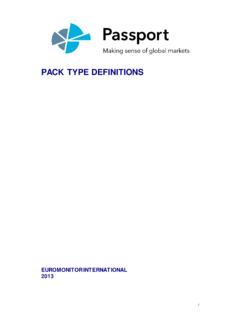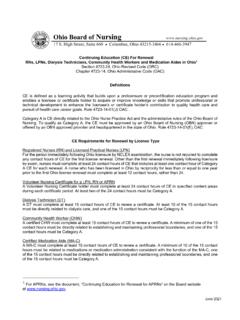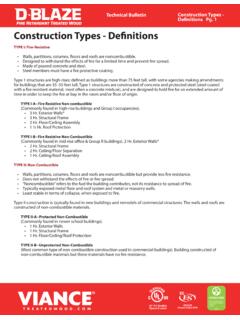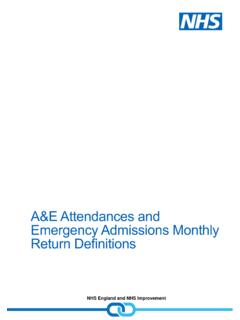Transcription of Packaging Type Definitions - Euromonitor Login
1 I PACK TYPE Definitions Euromonitor INTERNATIONAL 2013 ii List of Contents DATA TYPE DEF INITIONS ..1 Packaging SALES CHANNELS ..1 Retail/Off-Trade ..1 Packaging VOLUME ..1 Unit Re tail/Off-Trade Uni t Volume .. 1 Foodse rvi ce/On-Trade Uni t Volume .. 1 Total Uni t Volume .. 1 Product Volume ..2 Re tail/Off-Trade Product Vol ume .. 2 Foodse rvi ce/On-trade Product Volume .. 2 Total Product 2 Packaging CLASS ..2 Pri ma ry Pa cka ging .. 2 Se condary Pa ckagi ng .. 3 PACK TYP E DEFIN TOTAL Flexible Packaging ..5 Aluminium 5 Blis te r and Strip Pa cks .. 5 Fle xi ble Aluminium/Pape r .. 5 Fle xi ble Aluminium/Plasti c .. 6 Fle xi ble Pape r .. 6 Fle xi ble Pape r/Plasti c .. 6 Fle xi ble Plasti c .. 6 Stand-Up Aluminium/Plasti c 7 Plasti c Pouches .. 7 Glass Bottles .. 8 Glass Ja rs .. 8 Liquid Bri ck Liquid Ca 9 Ga ble-Top Liquid Ca rtons.
2 9 Shaped Liquid Ca 9 ..9 Aluminium Tra 10 Me tal Bottles .. 10 Collapsible Me tal Tubes .. 10 Ke gs .. 10 Me tal Ae rosol Cans .. 11 Me tal Be ve ra ge 11 Me tal Food 11 Me tal Tins .. 11 Othe r Me tal .. 12 Paper-Based Containers .. 13 Ba g In Box .. 13 Boa rd 13 Composite Containe rs .. 13 Folding Ca 13 Pape r-Based Tra ys .. 14 Rigid 15 HDPE 15 PET 15 PET Ja rs .. 15 iii Rea dy Meal Tra ys .. 16 Othe r Plas tic Tra 16 Spe ciality Cosme ti cs Containe 16 Squee zable Plas ti c 17 Thin Wall Plasti c Containe rs .. 17 Othe r Plas tic Bottles .. 17 Othe r Plas tic Ja rs .. 17 Othe r Rigid Containe rs .. 18 Other Packaging .. 18 Othe r Pa ckaging .. 18 1 DATA TYPE Definitions Packaging SALES CHANNELS Retail/Off-Trade Retail sales are defined as sales through establishments primarily engaged in the sale of goods for home use, preparation and/or consumption.
3 This includes grocery retailers, supermarkets/hypermarkets, discounters, convenience stores, independent small grocers, forecourt retailers, food/drink/tobacco specialists, department stores, mass merchandisers, variety stores, perfumeries, newsagent-tobacconists/kiosks, outdoor markets, pet superstores, pet shops, veterinary clinics, and other retailers. In the Packaging system we measure retail/off-trade unit volumes for all industries: Soft Drinks; Alcoholic Drinks; Hot Drinks; Tobacco; Beauty and Personal Care; Home Care; Dog and Cat Food; Tissue and Hygiene; and Packaged Food. Retail sales also include non-store retailing such as vending, homeshopping, internet retailing and direct selling. This excludes hotels, duty-free sales, wholesale industries (including cash-and-carry), warehouse clubs and institutional sales (canteens, prisons/jails, hospitals, army etc). Our retail definition EXCLUDES the purchase of food and beverage products from foodservice outlets for off-premise consumption, eg impulse confectionery bought from the counters of caf s/bars.
4 It also excludes the informal retail sector. Foodservice/On-Trade Foodservice sales are defined as sales to foodservice establishments. This includes full-service restaurants, caf s/bars, fast food outlets, 100% home delivery/takeaway, self-service cafeterias, street stalls/kiosks etc. In the Packaging system we measure foodservice/on-trade unit volumes for Soft Drinks and Alcoholic Drinks only. This excludes hotels, duty-free sales and institutional sales (canteens, prisons/jails, hospitals, army etc). Packaging VOLUME Unit Volume Unit volume is the number of units of Packaging sold to the consumer. For example a 1-litre PET bottle of carbonates would be counted as a unit volume of one unit (PET bottle, carbonates). Retail/Off-Trade Unit Volume Retail/off-trade unit volume is the number of Packaging units sold to the consumer through all retail channels. Retail/off-trade unit volume information is available for the following industries: Soft Drinks; Alcoholic Drinks; Hot Drinks; Tobacco; Beauty and Personal Care; Home Care; Dog and Cat Food; Tissue and Hygiene; and Packaged Food.
5 Foodservice/On-Trade Unit Volume Foodservice/on-trade unit volume is the number of Packaging units sold to foodservice outlets. Foodservice/on-trade unit volume information is available for Alcoholic Drinks and Soft Drinks only. Total Unit Volume Total unit volume is the aggregate of retail/off-trade and foodservice on-trade unit volume. Total unit volume information is available for Alcoholic Drinks and Soft Drinks only. 2 Product Volume Product volume is the amount of product contained in the Packaging as sold to the consumer. For example a 1-litre PET bottle of carbonates would be counted as a product volume of one litre (PET bottle, carbonates). Retail/Off-Trade Product Volume Retail/off-trade product volume is the amount of product sold to the consumer through all retail channels. This may be measured in litres, tonnes or units. Retail/off-trade product volume information is available for the following industries: Soft Drinks; Alcoholic Drinks; Hot Drinks; Tobacco; Beauty and Personal Care; Home Care; Dog and Cat Food; Tissue and Hygiene; and Packaged Food.
6 Foodservice/On-trade Product Volume Foodservice/on-trade unit volume is the amount of product sold to foodservice outlets. Foodservice/on-trade product volume information is available for Alcoholic Drinks and Soft Drinks only. Total Product Volume Total product volume is the aggregate of retail/off-trade and foodservice on-trade product volume. Total product volume information is available for Alcoholic Drinks and Soft Drinks only. Packaging CLASS For products utilising just one pack type, this Packaging is the primary Packaging . For products utilising more than one pack type, one item of Packaging will be the primary Packaging and all other items will be secondary Packaging . Primary Packaging For products utilising just one pack type, this Packaging is the primary Packaging . For most alcoholic and soft drinks there is only one type of Packaging for the product (ie the bottle, keg, liquid carton, or can).
7 For example: a metal beverage can of carbonates in this case the metal beverage can would be the primary Packaging . For products utilising more than one pack type, one item of Packaging will be the primary Packaging and all other items will be secondary Packaging . The primary pack type will be branded Packaging that is most closely associated with the product. Below we give some guidance on how to identify which pack type is the primary Packaging for different industries. For packaged foods this is the branded Packaging that the consumer sees on the shelf in the store. This is not necessarily the Packaging that is closest to the product, but normally the Packaging that offers the best protection for the product in terms of breakage. For example for breakfast cereals, the folding carton is the primary Packaging as it is the printed pack that remains on the shelf, offers the best protection from product breakage and is the pack type that influences the consumer s purchasing decision.
8 However, the folding carton also has an inner bag, so we count this also, but as secondary Packaging . For this reason in packaged foods folding cartons are most likely to be the primary pack type. For alcoholic and soft drinks there is typically only a primary Packaging , and it is uncommon to have any secondary pack type. An exception is gift packs, for example a glass bottle of spirit sold in a printed metal tin or printed folding carton. In this case the bottle is the primary pack type. This is because both the bottle and tin are branded, but the bottle is retained as the Packaging used to contain the product after purchase for the life of the product. This also ensures that all glass bottles in spirits are counted as primary regardless of the use of any gift Packaging . For beauty and personal care and home care the primary Packaging is the branded product that the consumer retains for the life of the product.
9 For example with a tube of toothpaste in a folding carton, the tube will be primary Packaging and the folding carton secondary. For this reason folding cartons are most likely to be secondary Packaging in the beauty and personal care and home care industries. 3 NOTE for products that come in kit form (present in categories such as colourants, perms and relaxants, tooth whiteners) the folding carton is considered to be primary Packaging . This is because the kit may contain a number of pack types and it will not be clear that any one is primary. It is also likely that the folding carton is the only branded Packaging and the kit is used in a single use, so the folding carton is not discarded before the product is used. Secondary Packaging Secondary Packaging is all other Packaging for the product. Examples: Instant soup the folding carton is primary and the inner sachet is secondary. Note that both the primary Packaging and secondary Packaging should be recorded with the same pack size.
10 For example a folding carton containing 5 x 10g aluminium/paper sachets would be recorded as a folding carton primary 50g and a flexible aluminium/paper secondary 50g NOT five secondary units of 10g. Biscuits the flexible plastic Packaging is primary and the other plastic tray is secondary Powder concentrates if a powder concentrate comes in a folding carton with an inner sachet, the carton is the primary Packaging and the inner bag needs to be classified by its flexible pack type as secondary Packaging . Examples of secondary Packaging for powder concentrates are flexible aluminium/paper or plastic. Tea note that for tea most of the primary Packaging will be the folding carton. If this folding carton is then wrapped in transparent plastic, the transparent plastic needs to go in as secondary flexible plastic. Please do not measure the tea bag itself (ie the paper around the tea leaves) as secondary paper, unless you have individually wrapped tea bags (ie the tea bag is in a paper envelope).





